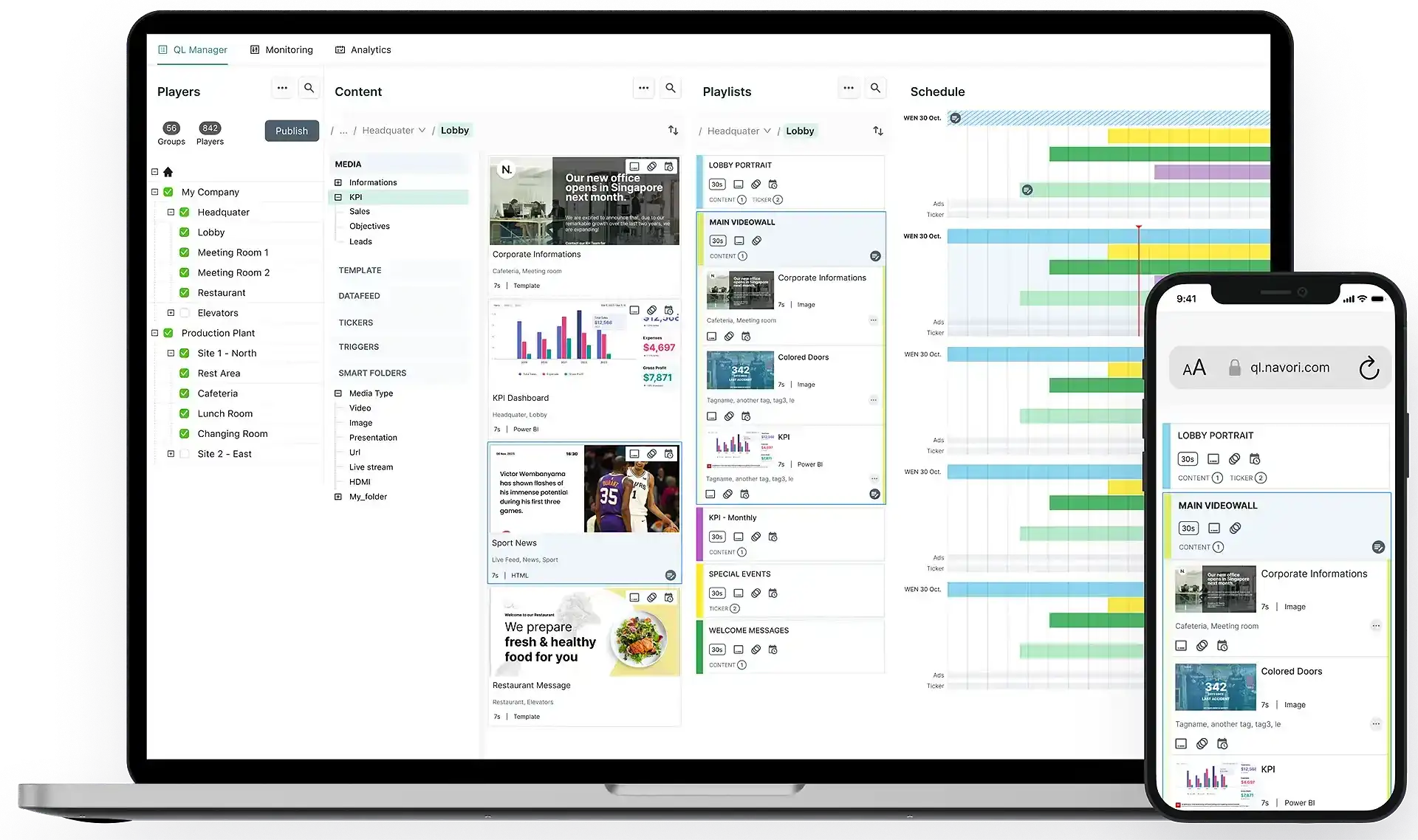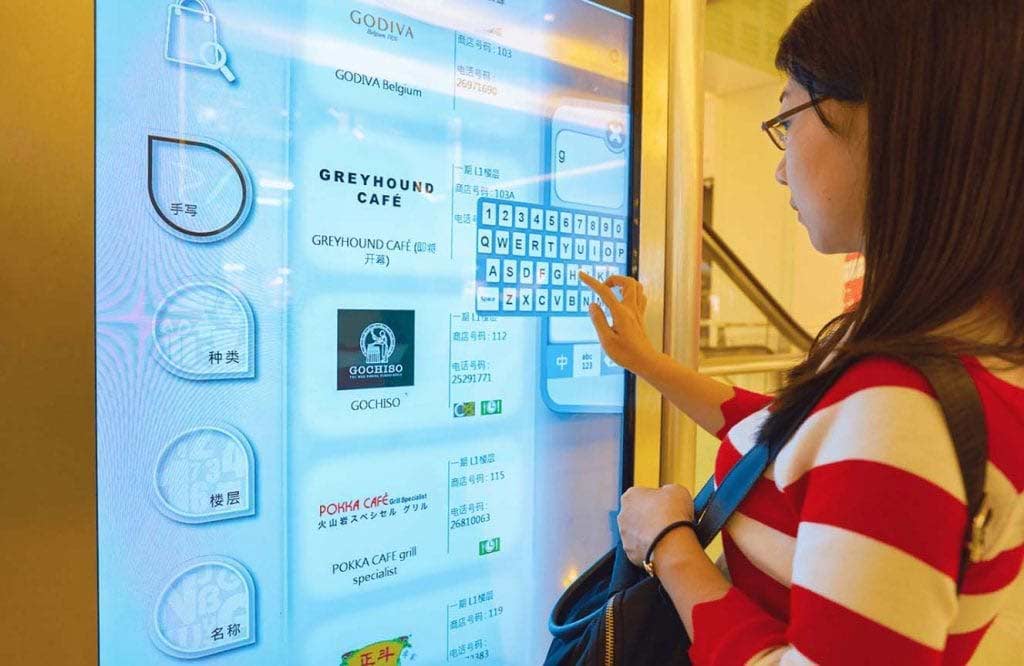Understanding How a Digital Signage Software System Works
The Digital Signage Server Software
Your digital signage software system must perform all these tasks as efficiently and reliably as possible. To achieve this, the software must be designed for continuous 24/7 operation.
Your digital signage server handles:
- Content storage
- Content scheduling
- Content rules and meta-tagging
- Proof of content playback
- Administrator and end-user access management
- Player communications
- Player status tracking
- Remote device management
There are two types of digital signage server software available on the market, on-premise, and software-as-a-service (or SaaS).
On-premise server software
On-premise solutions are installed and managed on your PC server hardware. Additionally, you have the option to install the software on a physical or virtual server hosted and managed by a third party.
On-premise software licenses are purchased outright and there are no monthly fees. Software maintenance services are usually offered separately and billed annually.
When should you consider an on-premise software solution?
- When data cannot be routed through a third-party cloud server due to regulatory requirements.
- When you don’t want to pay monthly fees.
- When you require total control over your digital signage network.
- When you already have a substantial investment in server hardware and you have the required technical staff who can install and manage the equipment.

Software-as-a-service (SaaS)
SaaS solutions work differently. For starters, they don’t require a big, up-front capital investment. You lease your software, and someone else takes care of installing and maintaining the system on your behalf.
Who should consider SaaS-based digital signage?
- Start-ups that are growing rapidly.
- Companies that can’t predict how many displays they might need, and who are unable or unwilling to commit to an on-premise solution.
- Enterprises that want the flexibility to add more displays over time without dedicated IT support staff.

The CMS Dashboard
The content management system provides the front-end services for the digital signage server software. It features a dashboard available as a locally installed software application or a multi-user accessible web-based front-end.
CMS dashboards must be…
- Easy to learn and use.
- Simple to install and maintain.
- Compatible with a wide range of hardware devices and operating systems.
- Accessible by multiple users at a time and provide real-time synchronization.
Web-based CMS dashboards require no local software to be installed on the end user’s computer. End-users simply connect to the system by typing a URL in their web browser.
The Media Player Software
The digital signage standalone player software is a critical part of any solution. It’s the software that renders the scheduled content and displays live data reliably, 24/7/365.
Here are some key features to look for:
- Make sure the player software supports a wide range of multimedia file formats.
- The software must be reliable and efficient.
- It must communicate its status to the CMS server so users know what’s going on at all times.
- It must be able to monitor the hardware’s resources and, if necessary, take corrective action on its own.
- It must be compatible with a range of hardware platforms and operating systems.

The Media Player Hardware
Your standalone player hardware should match the technical requirements of the digital signage player software.
Here are some of the requirements you should consider:
- The operating system (OS), such as Windows, Linux, MacOS, Android, ChromeOS, etc.
- The type of hardware that matches the OS such as:
- Windows PC.
- Android digital signage player
- System on Chip (SOC) display.
Windows PCs
Windows PCs continue to be extremely popular for digital signage use. They offer many advantages over other standalone player devices.
- Connect multiple screens to a single PC and show different content and information on each screen.
- Windows PCs can be accessed remotely for routine maintenance and to resolve technical issues.
- Windows continues to be the most popular PC operating system with global support.
- Windows expertise is readily available.
- Windows PCs are available in many sizes and form factors, including “sticks” that you can plug into any screen’s HDMI port.

Android tablets and media players
The operating system was conceived originally for mobile devices but has since become extremely popular for digital signage applications.
- Most tablets and standalone player devices come with the Android operating system.
- The Android operating system is open-source, meaning there are no additional expenses.
- Android is highly dependable and supports all digital signage features.
- Tablets and touchscreens support interactivity.
- Remote access software apps are now available for Android devices so you can perform routine maintenance tasks from any location.
- Android devices are available in compact sizes, making them easy to conceal behind screen screens.
System-on-chip displays
System-on-Chip (also known as SoC, or Smart TVs) integrates the standalone player hardware right inside the screen frame. Smart TVs have become extremely popular since their launch.
Smart TVs offer many advantages:
- You get a complete solution in a single screen.
- No exposed standalone player hanging off the back of the screen.
- The cost of the standalone player hardware is included in the price.
- Smart TVs are manufactured by some of the most reputable brands.
- They are less expensive than buying a PC or Android standalone player + screen + cabling.
Finding the right digital signage software system
Here are some features to look for…
- Digital signage software systems that are based on content “forward and store” tend to be more resilient and less prone to issues if the internet connection ever goes down. This type of software will continue playing content when the network connection is lost or interrupted.
- Your digital signage player software should support more than one type of hardware or operating system. Look for Windows PCs, and Android-based digital signage players or tablets as these are the two most popular hardware/OS platforms for digital signage.
- Smart TVs that rely on System-on-Chip hardware have become very popular. Look for digital signage solutions that support this technology.
- The CMS dashboard should be delivered as a web-based service. Furthermore, these HTML5-based dashboards don’t require any local software, eliminating the need for software maintenance.
- Look for full-featured digital signage solutions that are scalable, since these products make it easier to add more end-users and standalone player devices as your needs grow. Very large networks should consider solutions that support content delivery networks (CDN) and server load balancing.
- Look for digital signage software that is written in native programming languages. Additionally, this type of software is more efficient and makes full use of the media player’s hardware resources such as graphic processor units (GPUs) and CPUs. On the other hand, software written in interpreted languages doesn’t provide the same quality or efficiency.
In conclusion
Understanding how digital signage software works is key to choosing the right one for your needs. First, decide if you want an on-premise server software, which lets you control everything without monthly fees, or a Software-as-a-Service (SaaS) model, which is flexible and easy to maintain.
Next, think about the dashboard of the Content Management System (CMS), media player software, and hardware. Each part has important features.
It’s also vital to manage content well, make sure the player works well and efficiently, and consider the operating system, hardware, and how the system can grow.
There are many options, like Smart TVs with built-in technology and strong content-focused systems. You can tailor your digital signage to be effective, reliable, and ready for changes in your business.
In short, the best digital signage system isn’t just for showing messages. It should also make things run smoother and improve the experience for users. By thinking about these things, you can make sure your digital signage is not just useful but also a big plus for your business.
